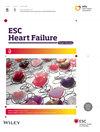Implementation of guidelines for intravenous iron therapy in heart failure patients
Abstract
Aims
We aim to evaluate the implementation of the 2021 ESC Guidelines regarding screening and treatment of iron deficiency in patients with heart failure (HF) at Karolinska University Hospital.
Methods and results
Patients with left ventricular ejection fraction (LVEF) < 50% and New York Heart Association (NYHA) class II–IV who visited Karolinska University Hospital in 2021 were identified through the registry SwedeHF. Data on patient characteristics, screening for iron deficiency, administration of ferric carboxymaltose (FCM) and HF medication were extracted from patients' health records. There were 261 patients registered whereof 141 (54%) were screened. Screened patients had lower LVEF [33% vs. 36% (P = 0.033)], higher N terminal pro brain natriuretic peptide levels [2880 ng/L vs. 1960 ng/L (P = 0.040)], higher prevalence of diabetes [31.9% vs. 20.0% (P = 0.030)] and were more often prescribed sodium-glucose co-transporter 2 inhibitors (SGLT2i) (49.6% vs. 25.8%) and loop diuretics [76.6% vs. 56.7% (both P < 0.001] compared with unscreened patients. Patients treated with intravenous iron had a higher NYHA class than untreated patients with an indication for treatment (P = 0.038).
Conclusions
In patients with HFrEF and HFmrEF, 54% were screened for iron deficiency. Screened patients had more advanced HF disease, possibly due to increased medical attention and higher compliance to guideline recommended treatment. We demonstrate that national quality registries can track outcomes and effectively enhance patient care.


 求助内容:
求助内容: 应助结果提醒方式:
应助结果提醒方式:


